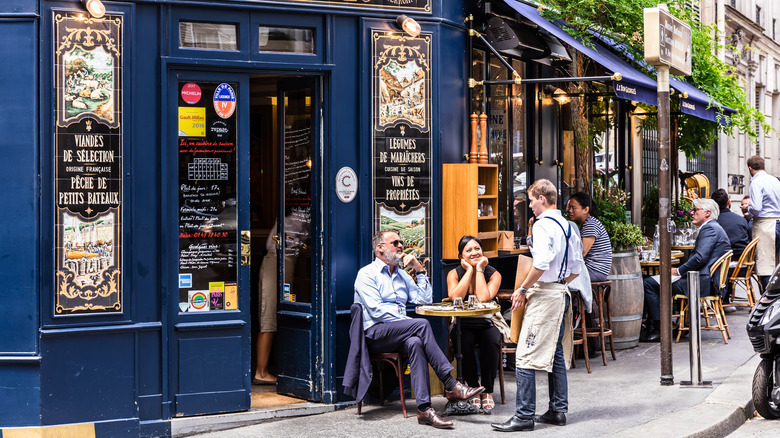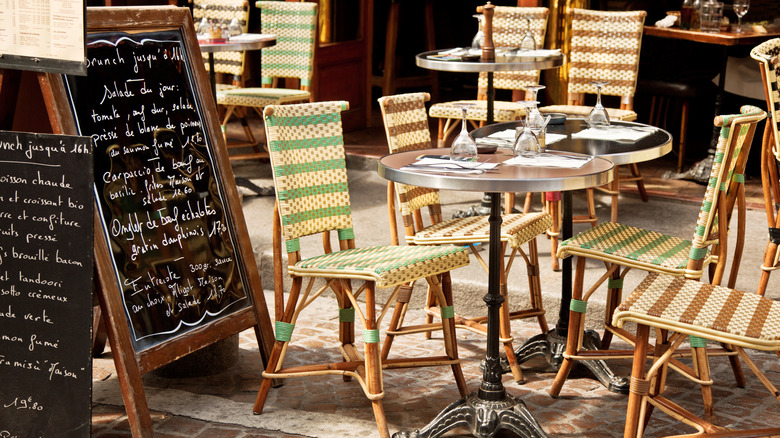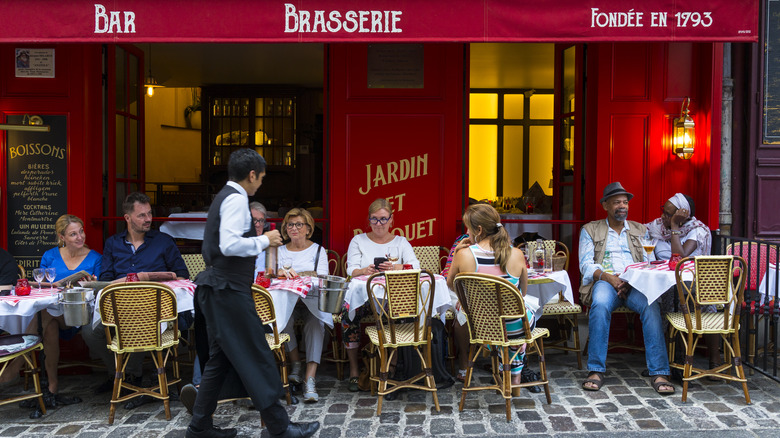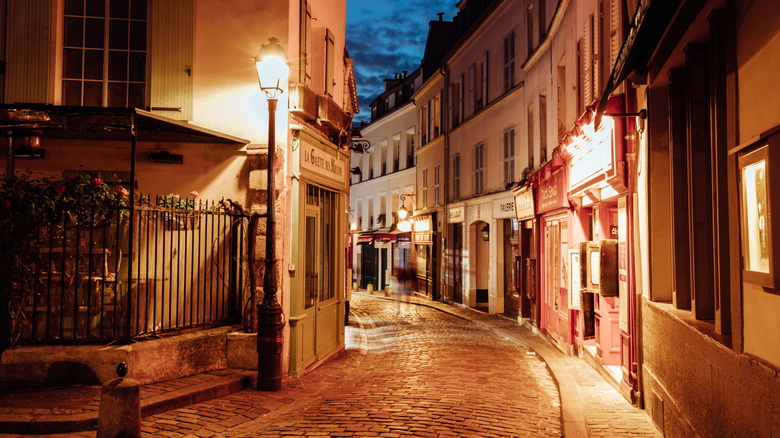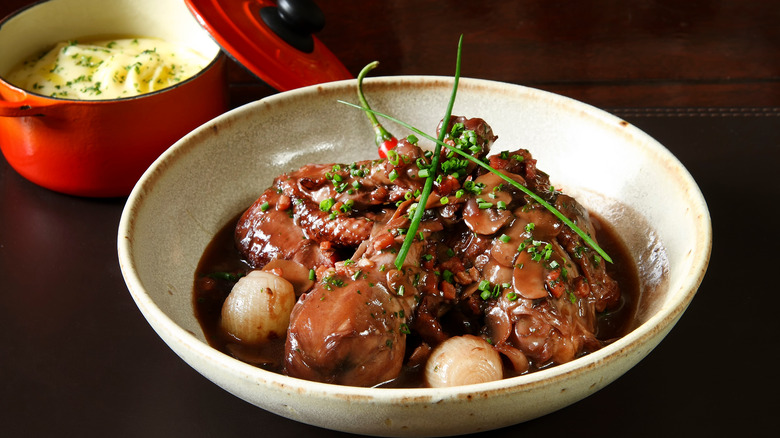Bistro Vs. Brasserie: What's The Difference?
If you are unfamiliar with French foods and dining traditions, it might seem like bistros and brasseries are one and the same. It's true that both types of establishments offer a range of food and drink options, and both can have a convivial and welcoming atmosphere. However, there are some fundamental distinctions between them that diners should know to determine which one best matches their moods and preferences.
While both establishments offer some of the best examples of French cuisine, bistros are more commonly associated with a casual ambiance and smaller menus, while brasseries typically feature a wide selection of food and extended hours. The histories of these establishments are also quite diverse, which plays a role in what sort of food diners can expect when seeking a delicious meal. Whether you're planning a trip to France and want to dine like a local or are just a Francophile with a love of learning, there are a few key facts to consider about these iconic French eateries.
What is a bistro?
Bistros are casual, speedy, and dependable dining establishments that often specialize in regionally specific food and drink. Derived from the Russian term for "quick," bistros reportedly first got their name from Russian soldiers seeking immediate assistance in France's cafés during and after the Napoleonic Wars, which lasted from 1803 until 1815. Upon entering a modern-day bistro, diners will often find the brief menu scrawled out on a chalkboard and fare that typically changes day to day based on what's in season at the market.
Bistros are all about efficient service, affordable prices, and a laid-back environment. In fact, the establishments were traditionally preferred by laborers seeking respite after a long day. In addition to food, these eateries provide wine, which is also usually sourced regionally, as well as coffee. While bistros do share some similarities with French cafés, the latter typically offer small plates and snacks, as opposed to the heartier, more complete meals you can enjoy when dining at the former.
What is a brasserie?
At their inception, brasseries were primarily devoted to brewing beer. In fact, the word brasserie translates to "brewery" in English, further highlighting these establishments' boozy beginnings. First appearing in Paris around the mid-1800s (and elsewhere in France decades before that), the brasserie concept was imported by Alsatian expatriates, who paired beer offerings with hearty food to offset the potency of the craft brews. Bofinger, first established by an Alsatian immigrant in 1864, still serves customers to this day and was the first establishment in Paris to sell beer that was stored in a keg and poured into glasses via a tap.
These days, brasseries still typically offer a varied selection of potent beverages, including beer, wine, and spirits, but they're also great places to enjoy a filling meal featuring some of the most flavorful fare France has to offer. In terms of size, brasseries tend to be quite large. They're also a far cry from the more formal settings one might imagine of a restaurant in France. Brasseries are ideal for enjoying a meal with friends and family without the need for formalities and fancy attire. Prices also tend to be a bit more affordable than higher-end establishments, although diners can expect a selection of high-quality food when perusing the menu.
Bistros offer limited hours, brasseries are open all day
If you want to visit a French bistro, you must time your trip carefully. These establishments usually only serve diners at certain times of the day, namely lunch and dinner. While exact hours can vary from place to place, lunch in France is typically available between the hours of 12 p.m. and 3 p.m., while dinner service begins at about 7 p.m. Keep in mind that the majority of bistros are closed at other times of the day.
As for brasseries, they often serve customers at various times of the day, starting in the morning with breakfast service. Brasseries also keep late hours, which allows hungry diners to indulge in wholesome fare late into the evening. These late hours ensure that people enjoying the nightlife in France can find a good meal once the fun has ended. And unlike bistros, brasseries don't usually shut down between lunch and dinner, meaning you can enjoy a drink or a bite to eat virtually any time.
Brasseries offer expansive menus, while bistros have a regional focus
Regional dishes are often the stars of bistro menus, and France is home to many culinary traditions. For example, an establishment in the south of France may offer crème catalane for dessert, while one in Brittany might serve the sweet or savory buckwheat crêpes known as Galettes Bretonnes. Some bistros feature a more comprehensive beverage selection as compared to menu items, with wines being a major player among the drink offerings. However, diners can usually look forward to a reasonably priced wine selection to match the casual bistro atmosphere.
Compared to bistros, the menus at brasseries often feature a far more comprehensive number of options. Instead of focusing on regional dishes, brasseries cook a vast array of traditional French fare. Diners perusing the often extensive menus are likely to see items like coq au vin, which is chicken cooked in a (typically red) wine-based stock. Other commonly encountered dishes include moules frites, or steamed mussels, and choucroute garnie, a traditional brasserie dish featuring meat and sausage over a base of sauerkraut that has culinary roots in Alsace (which borders Germany).
Bistros feature a laid-back ambiance, while brasseries are generally livelier
If you're seeking a low-key time in a quiet and relaxed atmosphere, bistros are the perfect option. It's not uncommon for people to linger at bistros for some time; the small size of these establishments tends to create a more intimate mood. Bistros make the perfect setting for dinner dates, but they can also be a wise selection when you want to enjoy an unbelievable meal in a serene setting without much activity going on around you.
Brasseries offer the opposite experience and tend to be quite lively and energetic. Because brasseries usually feature more room than bistros, you can expect a larger crowd, and the emphasis on adult beverages means that people are often seeking a boisterous time when dining at a brasserie. As a result, diners should be prepared for the festive setting, which can be quite fun and engaging depending on the type of experience you're looking for.
Both bistros and brasseries offer a uniquely French dining experience, from the items appearing on the menu to the décor featured in each establishment. Because these experiences are so different, visitors to France are encouraged to patronize each type of establishment to get a feel for the country's culinary culture.
